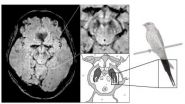(Press-News.org) ANN ARBOR, Mich. – About 25 percent of parents who have children aged two to five say their children get three or more hours of entertainment screen time a day, well beyond recommended limits, according to a new poll from the University of Michigan.
In the latest University of Michigan Mott Children's Hospital National Poll on Children's Health, a little more than half of those parents do try to set some limits by location: banning media devices from places like the bedroom or at mealtime.
In 2013, the American Academy of Pediatrics issued updated guidelines to recommend limits on screen time for children. The AAP discourages any screen time for children less than two years of age. For older children, the AAP recommends no more than two hours daily. The AAP suggests keeping media devices out of children's bedrooms, keeping family routines like mealtime screen-free, and setting screen-free days for the whole family.
The poll found that 53 percent of parents are following recommendations that children's entertainment screen time be limited by location. Twenty-eight percent said they use a combination of location and time limits.
But 13 percent said they do not limit entertainment screen time or locations for their young children.
The poll was administered in March 2014 and reflects the responses of 560 parents of children 1- to 5-years-old.
"In our poll, we found that one-quarter of parents of kids two to five years old are allowing more than three hours of entertainment screen time each day. That is more than is recommended," says April Khadijah Inniss, M.D., pediatrician at the University of Michigan Health System and research fellow in the Robert Wood Johnson Foundation Clinical Scholars Program.
"When you get to three or four hours each day, that screen time crowds out other important activities that babies and young kids should be engaging in: looking at books, going for walks or playing outside," says Matthew M. Davis, M.D., M.A.P.P., director of the C.S. Mott Children's Hospital National Poll on Children's Health.
Parents' views about reasonable screen time differ by the age of their children and do not necessarily match the AAP recommendations, the poll found. Among parents of children younger than two years old, only 12 percent think that no entertainment screen time is reasonable. In contrast, among parents of children 2-5 years old, 88 percent say that two hours or less of entertainment screen time is reasonable each day.
But Davis adds that limiting children's screen time remains challenging in a swiftly changing media landscape. That screen time now goes beyond television and videos to smartphones and tablets.
More parental education in this case is not necessarily the answer. Children's healthcare providers should try to understand and troubleshoot obstacles that young patients' families are facing regarding screen time, says Matthew M. Davis, M.D., M.A.P.P., who is director of the C.S. Mott Children's Hospital National Poll on Children's Health and professor of pediatrics and internal medicine at the U-M Medical School and professor of public policy at U-M's Gerald R. Ford School of Public Policy. Davis recommends to his own patients and families that limiting by location is a good first step.
"The most common approaches to limiting screen time have more to do with location than counting minutes. That makes sense. It's easier to say no smartphones at the table, than to be watching the clock," says Davis, who also is professor of Health Management and Policy at U-M's School of Public Health.
Inniss says the national conversation about children and screen time has to expand to include quality as well as quantity.
"Future efforts must concentrate on how media sectors concerned with children's healthy development can work together to produce and promote higher quality screen-based experiences," Inniss says. "This is an important next stage, because there is growing evidence that how young children interact with screen media is at least as important as how much time they spend."
INFORMATION:
Broadcast-quality video is available on request. See the video here:
https://www.youtube.com/watch?v=7k_5nQCiQ-k
Full report:
http://mottnpch.org/reports-surveys/screening-out-screen-time-parents-limit-media-use-young-children
Resources:
Common Sense Media: https://www.commonsensemedia.org/
Healthy Children.org: How to Make a Family Media Use Plan
Joan Ganz Cooney Center: Learning at Home: Families' Educational Media Use in America (PDF)
Website: Check out the Poll's website: MottNPCH.org. You can search and browse over 80 NPCH Reports, suggest topics for future polls, share your opinion in a quick poll, and view information on popular topics. The National Poll on Children's Health team welcomes feedback on the website, including features you'd like to see added. To share feedback, e-mail NPCH@med.umich.edu.
Facebook: http://www.facebook.com/mottnpch
Twitter: @MottNPCH
Purpose/Funding: The C.S. Mott Children's Hospital National Poll on Children's Health – based at the Child Health Evaluation and Research Unit at the University of Michigan and funded by the University of Michigan Health System – is designed to measure major health care issues and trends for U.S. children.
Data Source: This report presents findings from a nationally representative household survey conducted exclusively by GfK Custom Research, LLC (GfK), for C.S. Mott Children's Hospital via a method used in many published studies. The survey was administered in March 2014 to a randomly selected, stratified group of adults age 18 or over from GfK's web-enabled KnowledgePanel® that closely resembles the U.S. population. Responses from parents with a child age 1-5 (n=560) were used for this report. The sample was subsequently weighted to reflect population figures from the Census Bureau. The survey completion rate was 61 percent among panel members contacted to participate. The margin of error is 3 to 5 percentage points and higher among subgroups.
Findings from the U-M C.S. Mott Children's Hospital National Poll on Children's Health do not represent the opinions of the investigators or the opinions of the University of Michigan.
Screening out: What are parents doing to limit screen time for young children?
Fifty-three percent say they limit media devices by location, banning use in the bedroom or at mealtime, says U-M National Poll on Children's Health
2014-04-29
ELSE PRESS RELEASES FROM THIS DATE:
People rely on what they hear to know what they're saying
2014-04-29
You know what you're going to say before you say it, right? Not necessarily, research suggests. A study from researchers at Lund University in Sweden shows that auditory feedback plays an important role in helping us determine what we're saying as we speak. The study is published in Psychological Science, a journal of the Association for Psychological Science.
"Our results indicate that speakers listen to their own voices to help specify the meaning of what they are saying," says researcher Andreas Lind of Lund University, lead author of the study.
Theories about how ...
NOAA reports show strong economic gains from fishing, continued improvement in fish stocks
2014-04-29
U.S. commercial and recreational saltwater fishing generated more than $199 billion in sales in 2012, a gain of seven percent over the previous year, with the economic impact of fishing jobs increasing three percent from 2011 to 2012, according to a new NOAA Fisheries economics report.
Further, two more fish stocks were rebuilt to target levels in 2013, bringing the number of rebuilt U.S. marine fish stocks to 34 since 2000, according to another NOAA Fisheries report also released today.
Taken together, the two reports, Fisheries Economics of the United States 2012 ...
RI Hospital: Medicare patients with dementia 20 percent more likely to be readmitted
2014-04-29
PROVIDENCE, R.I. – A review of more than 25,000 admissions of Medicare beneficiaries to Rhode Island hospitals has found that patients with a documented diagnosis of dementia are nearly 20 percent more likely to be readmitted within 30 days than those without dementia. The study by Rhode Island Hospital researchers is published online in advance of print in the journal Archives of Gerontology and Geriatrics.
"Persons with dementia may have difficulties comprehending and following important discharge instructions, (e.g. medication changes, decision making, self care)," ...
Model sheds new light on sports-related brain injuries
2014-04-29
A new study has provided insight into the behavioral damage caused by repeated blows to the head. The research provides a foundation for scientists to better understand and potentially develop new ways to detect and prevent the repetitive sports injuries that can lead to the condition known as chronic traumatic encephalopathy (CTE).
The research – which appears online this week in the Journal of Neurotrauma – shows that mice with mild, repetitive traumatic brain injury (TBI) develop many of the same behavioral problems, such as difficultly sleeping, memory problems, ...
A risk management framework improves health systems' resilience to high-impact weather
2014-04-29
WASHINGTON — April 29, 2014 - According to a new study by the American Meteorological Society (AMS) Policy Program, a risk management framework can improve the resilience of healthcare facilities and services to high-impact weather such as tornadoes and hurricanes. The report is based on a recent AMS Policy Program workshop, A Prescription for the 21st Century: Improving Resilience to High-Impact Weather for Healthcare Facilities and Services, held in Washington, DC in October 2013.
The purpose of the study was to explore methods for improving the resilience of the health ...
Brain tumor cells penetrated by tiny, degradable particles carrying genetic instructions
2014-04-29
Working together, Johns Hopkins biomedical engineers and neurosurgeons report that they have created tiny, biodegradable "nanoparticles" able to carry DNA to brain cancer cells in mice.
The team says the results of their proof of principle experiment suggest that such particles loaded with "death genes" might one day be given to brain cancer patients during neurosurgery to selectively kill off any remaining tumor cells without damaging normal brain tissue.
A summary of the research results appeared online on April 26 in the journal ACS Nano.
"In our experiments, ...
Major lung resection safer than ever, especially at the busiest hospitals
2014-04-29
Toronto, ON, Canada, April 29, 2014 – A major new study using data from the National Cancer Data Base details the impact of annual hospital volume on 30- and 90-day mortality rates. Investigators found that major lung surgery has become progressively safer over the last few decades, although higher death rates at low-volume hospitals and an unexpected increase in mortality at 90 days compared to 30 days were observed. The study further suggests that choosing a center that performs major lung surgery regularly can have a strong impact on survival.
Lung cancer is the leading ...
'Tell-tail' MRI image diagnosis for Parkinson's disease
2014-04-29
An image similar in shape to a Swallow's tail has been identified as a new and accurate test for Parkinson's disease. The image, which depicts the healthy state of a group of cells in the sub-region of the human brain, was singled out using 3T MRI scanning technology – standard equipment in clinical settings today.
The research was led by Dr Stefan Schwarz and Professor Dorothee Auer, experts in neuroradiology in the School of Medicine at The University of Nottingham and was carried out at the Queen's Medical Centre in collaboration with Dr Nin Bajaj, an expert in Movement ...
CWRU researchers profile women's employment, caregiving workloads, effort and health
2014-04-29
A study from the Case Western Reserve University nursing school provides a profile of women with the dual responsibilities of full-time paid work and unpaid care for an elderly family member.
"We often hear caregivers talk about 'how much time and effort it takes' to provide care for their family members or neighbors," said Evanne Juratovac, PhD, RN (GCNS-BC), assistant professor of nursing at the Frances Payne Bolton School of Nursing and the study's lead researcher, "so we examined the experience of doing the workload on these women caregivers as the 'workers."
She ...
NAI Fellows paper on patents and commercialization for tenure, career advancement in PNAS
2014-04-29
TAMPA, Fla. (April 29, 2014) – When six university leaders took the stage at the 2013 Annual Conference of the National Academy of Inventors (NAI), held just over a year ago at the University of South Florida, they began a national conversation on changing the academic culture to recognize faculty patents and commercialization activity toward tenure and promotion. That conversation, according to NAI president Paul R. Sanberg, was long overdue.
The question posed to the panel, "Would Thomas Edison Receive Tenure," was answered with a clear "yes" and the paper that resulted, ...
LAST 30 PRESS RELEASES:
Bharat Innovates 2026 National Basecamp Showcases India’s Most Promising Deep-Tech Ventures
Here’s what determines whether your income level rises or falls
SCIE indexation achievement: Celebrate with Space: Science & Technology
Children’s Hospital Colorado performs region’s first pediatric heart and liver dual organ transplant
Australian team discover why quantum computers have memory problems over time
What determines the fate of a T cell?
Candida auris: genetic process revealed which could be treatment target for deadly fungal disease
Groundbreaking discovery turns household plastic recycling into anti-cancer medication
Blocking a key inflammatory pathway improves liver structure and vascular function in cirrhosis, study finds
Continuous spread: Raccoon roundworm detected in nine European countries
HKUST Engineering researchers developed a novel photodetector to enhance the performance of on-chip light monitoring
Strategic river sensors could have forewarned of Texas Camp flood disaster
Drone sampling of whale breath reveals first evidence of potentially deadly virus in Arctic
Roman soldiers defending Hadrian’s Wall infected by parasites, study finds
Pinochet’s prisoners were tormented with music but still found solace in it, a new book reveals
Fertility remains high in rural Tanzania despite access to family planning
AI-assisted device can improve autism care access
Kinetic careers
Uncovering how parasitic plants avoid attacking themselves to improve crop resistance
Nanoparticle vaccine strategy could protect against Ebola and other deadly filoviruses
Study finds brain care score can predict risk of stroke across racial groups
Key lung immune cells can intensify allergic reactions
Do hormones explain why women experience more gut pain?
New materials conduct ions in solids as easily as in liquids
Breakthrough of the Year: Renewable energy begins to eclipse fossil fuel-based sources
LLM use is reshaping scientific enterprise by increasing output, reducing quality and more
Introducing LightGen, a chip for ultra-fast, ultra-efficient generative AI
Astronomers see fireworks from violent collisions around nearby star
ACC/AHA issue new guideline on managing congenital heart disease in adults
Cosmic crash caught on camera
[Press-News.org] Screening out: What are parents doing to limit screen time for young children?Fifty-three percent say they limit media devices by location, banning use in the bedroom or at mealtime, says U-M National Poll on Children's Health


